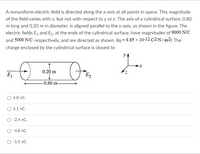
College Physics
11th Edition
ISBN: 9781305952300
Author: Raymond A. Serway, Chris Vuille
Publisher: Cengage Learning
expand_more
expand_more
format_list_bulleted
Concept explainers
Question

Transcribed Image Text:A nonuniform electric field is directed along the x-axis at all points in space. This magnitude
of the field varies with x, but not with respect to y or z. The axis of a cylindrical surface, 0.80
m long and 0.20 m in diameter, is aligned parallel to the x-axis, as shown in the figure. The
electric fields E1 and E2, at the ends of the cylindrical surface, have magnitudes of 9000 N/C
and 5000 N/C respectively, and are directed as shown. (s0 = 8.85 × 10-12 C2/N•m2) The
charge enclosed by the cylindrical surface is closest to
0.20 m
E1
E2
-0.80 m
4.8 nC.
O 1.1 nC.
-2.4 nC.
-4.8 nC.
-1.1 nC.
Expert Solution
This question has been solved!
Explore an expertly crafted, step-by-step solution for a thorough understanding of key concepts.
This is a popular solution
Trending nowThis is a popular solution!
Step by stepSolved in 3 steps with 3 images

Knowledge Booster
Learn more about
Need a deep-dive on the concept behind this application? Look no further. Learn more about this topic, physics and related others by exploring similar questions and additional content below.Similar questions
- Inside a cathode ray tube, an electron is in the presence of a uniform electric field with a magnitude of 275 N/C. (a) What is the magnitude of the acceleration of the electron (in m/s2)? m/s2 (b) The electron is initially at rest. What is its speed (in m/s) after 1.20 ✕ 10−8 s? m/sarrow_forwardA uniform electric field 3.41E3 N/C is applied in a cubic box with each side being 2.23 m long. What is the energy stored by the electric field in the box (in J)?arrow_forwardAn alpha particle (a helium nucleus) is traveling along the positive x-axis at 1075 m/s when it enters a cylindrical tube of radius 0.800 cm centered on the x-axis. Inside the tube is a uniform electric field of 3.00 10-4 N/C pointing in the negative y-direction. How far does the particle travel before hitting the tube wall? Neglect any gravitational forces. Note: m? = 6.64 10-27 kg; q? = 2e. marrow_forward
- Two parallel, uniformly charged, infinitely long wires carry opposite charges with a linear charge density λ = 1.00 μC/m and are 4.22 cm apart. What is the magnitude of the electric field at a point midway between them and 44.2 cm above the plane containing the two wires?arrow_forwardA small object of mass 3.54 g and charge −19.3 ?C is suspended motionless above the ground when immersed in a uniform electric field perpendicular to the ground. What are the magnitude and direction of the electric field? magnitude directionarrow_forwardA proton enters a region of uniform electric field of magnitude 79.9 N/C with an initial velocity of 19.6 km/s directed perpendicularly to the electric field. What is the speed of the proton 2.03 μs after entering this region? O 30.0 km/s O 19.6 km/s O 25.0 km/s O 32.5 km/s O 27.5 km/sarrow_forward
- In the figure a uniform, upward electric field of magnitude 1.60 × 103 N/C has been set up between two horizontal plates by charging the lower plate positively and the upper plate negatively. The plates have length L = 17.0 cm and separation d = 1.70 cm. An electron is then shot between the plates from the left edge of the lower plate. The initial velocity of the electron makes an angle 0 = 45.0° with the lower plate and has a magnitude of 6.40 × 105 m/s. (a) Will the electron strike one of the plates? (b) If so, which plate, top or bottom? (c) How far horizontally from the left edge will the electron strike? ↑E 5%8 (a) (b) (c) Number Mr Units <arrow_forwardInside a vacuum tube, an electron is in the presence of a uniform electric field with a magnitude of 320 N/C. (a). What is the magnitude of the acceleration of the electron (in m/s2)? m/s2 ?? (b). The electron is initially at rest. What is its speed (in m/s) after 1.15 ✕ 10−8 s? m/s ?arrow_forwardI need help for these questions, I am studying for the physics exam and I couldn't solve this questions which are in the study plan of physics-102. Thanks in advance.arrow_forward
arrow_back_ios
arrow_forward_ios
Recommended textbooks for you
 College PhysicsPhysicsISBN:9781305952300Author:Raymond A. Serway, Chris VuillePublisher:Cengage Learning
College PhysicsPhysicsISBN:9781305952300Author:Raymond A. Serway, Chris VuillePublisher:Cengage Learning University Physics (14th Edition)PhysicsISBN:9780133969290Author:Hugh D. Young, Roger A. FreedmanPublisher:PEARSON
University Physics (14th Edition)PhysicsISBN:9780133969290Author:Hugh D. Young, Roger A. FreedmanPublisher:PEARSON Introduction To Quantum MechanicsPhysicsISBN:9781107189638Author:Griffiths, David J., Schroeter, Darrell F.Publisher:Cambridge University Press
Introduction To Quantum MechanicsPhysicsISBN:9781107189638Author:Griffiths, David J., Schroeter, Darrell F.Publisher:Cambridge University Press Physics for Scientists and EngineersPhysicsISBN:9781337553278Author:Raymond A. Serway, John W. JewettPublisher:Cengage Learning
Physics for Scientists and EngineersPhysicsISBN:9781337553278Author:Raymond A. Serway, John W. JewettPublisher:Cengage Learning Lecture- Tutorials for Introductory AstronomyPhysicsISBN:9780321820464Author:Edward E. Prather, Tim P. Slater, Jeff P. Adams, Gina BrissendenPublisher:Addison-Wesley
Lecture- Tutorials for Introductory AstronomyPhysicsISBN:9780321820464Author:Edward E. Prather, Tim P. Slater, Jeff P. Adams, Gina BrissendenPublisher:Addison-Wesley College Physics: A Strategic Approach (4th Editio...PhysicsISBN:9780134609034Author:Randall D. Knight (Professor Emeritus), Brian Jones, Stuart FieldPublisher:PEARSON
College Physics: A Strategic Approach (4th Editio...PhysicsISBN:9780134609034Author:Randall D. Knight (Professor Emeritus), Brian Jones, Stuart FieldPublisher:PEARSON

College Physics
Physics
ISBN:9781305952300
Author:Raymond A. Serway, Chris Vuille
Publisher:Cengage Learning

University Physics (14th Edition)
Physics
ISBN:9780133969290
Author:Hugh D. Young, Roger A. Freedman
Publisher:PEARSON

Introduction To Quantum Mechanics
Physics
ISBN:9781107189638
Author:Griffiths, David J., Schroeter, Darrell F.
Publisher:Cambridge University Press

Physics for Scientists and Engineers
Physics
ISBN:9781337553278
Author:Raymond A. Serway, John W. Jewett
Publisher:Cengage Learning

Lecture- Tutorials for Introductory Astronomy
Physics
ISBN:9780321820464
Author:Edward E. Prather, Tim P. Slater, Jeff P. Adams, Gina Brissenden
Publisher:Addison-Wesley

College Physics: A Strategic Approach (4th Editio...
Physics
ISBN:9780134609034
Author:Randall D. Knight (Professor Emeritus), Brian Jones, Stuart Field
Publisher:PEARSON